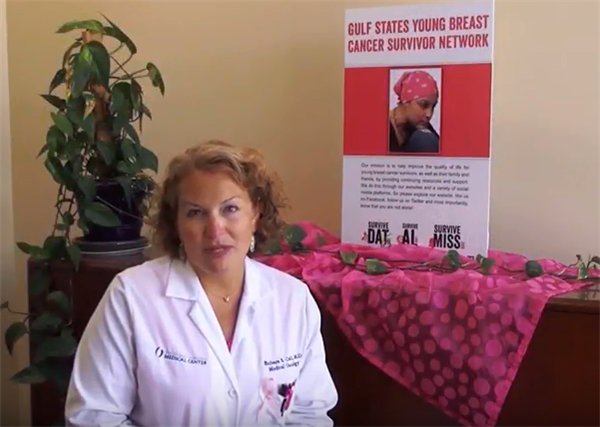Where did your cancer start?
Milk Ducts
They carry breast milk from the lobules to the nipple. The most common type of breast cancer, ductal carcinoma, forms in the lining of milk ducts.
Lobules
This is where breast milk is made. Lobular carcinoma is formed in these milk-producing areas.
Connective Tissues
It is rare, but breast cancer can form in the muscle, fat and blood vessels. This type of cancer is called a sarcoma.
Has your cancer spread?
Non-Invasive
This type of cancer is when the cancer cells are contained in one area, and is called in situ, meaning “in place.”
Invasive
This type of cancer is when the cancer cells have spread from the original site into surrounding tissues.
Dr. Craft is an Associate Professor of Medicine in the Oncology department at the University of Mississippi Medical Center. She also serves as the Principle Investigator at the University of Mississippi for SurviveMISS. In the video, Dr. Craft discusses metastatic breast cancer and different types of treatment options, as well as side effects.
*Metastatic cancer occurs when the cancer has spread beyond the breast to other organs and is considered advanced in stage. This type of breast cancer is seen after treatment is completed. *Inflammatory breast cancer occurs in the breast tissue making it swollen, red and painful. This type of breast cancer is rare, but fast growing. At diagnosis, it is usually already in an invasive state and has spread, usually to lymph nodes and the chest wall, but not to other organs. On some occasions, inflammatory breast cancer can be considered metastatic if the cancer has spread to other organs.
What do your cancer cells look like under a microscope?:
Cancer Cells Have an Altered Appearance
You can classify subtypes of cancer by how the cells look up close. This can help doctors identify the best way to treat your cancer. Different subtypes include tubular, mucinous, medullary and papillary.
How Your Cancer Cells Look Different From Your Healthy Cells
Breast cancer is graded on a scale, with one (1) looking only slightly different with slow growth and three (3) looking very different from your healthy cells with fast growth. The grade relates to the aggressiveness of the cancer.
Are Your Cancer Cells Sensitive to Hormones?:
Knowing which hormones affect your cancer will help doctors understand what treatment is right for you.
Estrogen Receptor (ER) Positive
This type of breast cancer is sensitive to estrogen and has many hormone receptors.
Progesterone Receptor (PR) Positive
This type of breast cancer is sensitive to progesterone and has many hormone receptors.
Hormone Receptor (HR) Negative
This type of cancer is not sensitive to either estrogen or progesterone, has little or no hormone receptors, and therefore does not respond to hormone therapy.
*Estrogen and Progesterone are common hormones used in birth control. Treatment of breast cancer often uses hormone therapy to block these hormones from getting to the cancer cells, which can render your birth control ineffective. Make sure you talk to your doctor about other birth control options during treatment.
What Genes Are in Your Cancer Cells?:
HER2 Positive: This gene produces growth-promoting proteins. If there are too many copies of this gene, cancer can grow at a faster rate.
HER2 Negative: This type of cancer does not have an excess of HER2, so it does not respond to treatments that target HER2.
*If a cancer is both Hormone Receptor (HR) Negative and HER2 Negative, then it is called Triple Negative because it does not respond to estrogen-blocking, progesterone-blocking, or HER2 targeted treatments.
Useful Websites:
American Cancer Society/Types of Breast Cancers:
Breastcancer.org/Types of Breast Cancer:
Susan G. Komen/Factors That Affect Prognosis and Treatment:
Videos to Watch:

Dr. Craft Discusses Metastatic Breast Cancer
Dr. Craft is an Associate Professor of Medicine in the Oncology department at the University of Mississippi Medical Center. She also serves as the Principle Investigator at the University of Mississippi for SurviveMISS. In the video, Dr. Craft discusses metastatic breast cancer and different types of treatment options, as well as side effects.
watch video